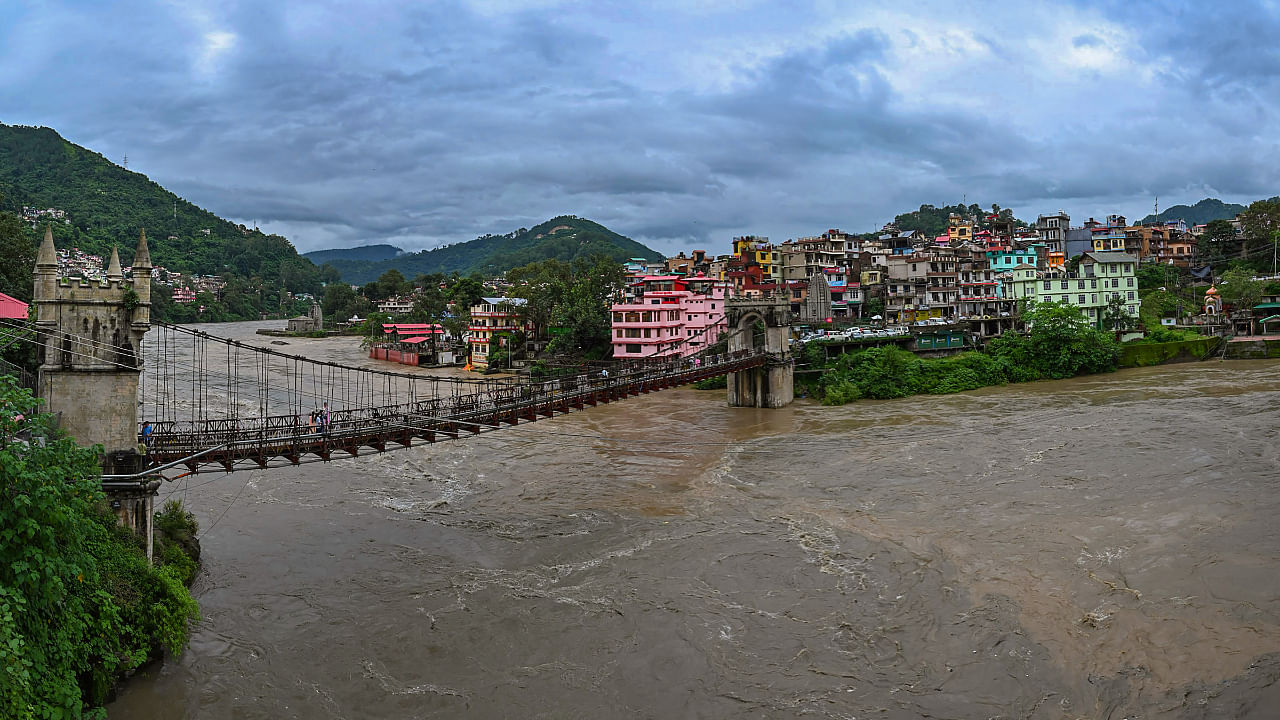
Swollen Beas river following heavy monsoon rains, in Mandi district, Aug. 11, 2022.
Credit: PTI File Photo
Back-to-back western disturbances have brought heavy rains in the southern states of Karnataka, Tamil Nadu, and Kerala. Rains also bring the fear of flooding, landslides, etc. Until a month back weather-related calamities were unfolding one after the other in India’s northern states, especially in the Indian Himalayan Region (IHR). With the focus now on the south, one should not forget to address why the IHR has seen such calamities in the recent past.
There are no two ways about the fact that the current development model is not ideal for the IHR. The IHR is the section of the Himalayas within India, spanning Ladakh, Jammu & Kashmir, Himachal Pradesh, Uttarakhand, Sikkim, Meghalaya, Assam, Tripura, Mizoram, Manipur, Nagaland, Arunachal Pradesh, and West Bengal. The IHR stretches 2,500 km covering 5.3 lakh km2 and nearly 46 million people reside in this region. The Himalayas are a perennial source of water, and it has three important river basins: the Indus, the Ganges, and the Brahmaputra. For its large reserve of glacial ice, it is also known as the Third Pole.
The unsustainable way of development
All throughout its history, this region has seen numerous waves of migrations. All the groups that migrated to the region lived well within its resources, thereby not disturbing the ecological sensitivities of the Himalayas. The arrival of the British colonisers upset this equilibrium. The British saw the IHR for its utilitarian value, primarily to support the empire’s demand for wood. Thus, the forest Acts were drawn.
This attitude towards the IHR should have changed after Independence, but it did not. As India moved towards development, the IHR was seen not as an ecologically-sensitive region with a rich biodiversity, but as a resource to fuel this development.
The State assessed the region for its utilitarian purpose and was tapped for its forest wealth, hydropower, tourism, etc. The lawmakers were not sensitive to the fact that development was coming at the cost of the region. This is a flawed model of development.
Disasters and a flawed model of development
The Himalayas are the youngest range of mountains in the world where still plate movements are taking place and new formations are witnessed. In such a scenario infrastructure development, be it widening roads or building more concrete structures, is detrimental. In recent months two tourist hotspots in Himachal Pradesh were cut off after floods and landslides wreaked havoc.
Infrastructural development also leads to widespread deforestation — which in turn leads to a reduction in green cover, landslides, etc. The Teesta River tragedy was a foreseen disaster. Despite several warnings not much attention was paid to the risks pointed out by concerned citizens. The Joshimath hydropower is speculated to have contributed to the recent subsidence of the entire urban settlement there. Waste disposal due to developmental activities is another major concern in the IHR.
A tough question that needs to be asked is whether the IHR needs the tourism development that it is currently exposed to. Can the ecosystem sustain such huge volumes? Development and tourism should take place, but with little damage to the ecosystem.
The impact of Climate Change in the IHR has led to unpredictable outcomes and when coupled with unscientific development, extreme weather conditions have led to disasters.
What should be done
With an increase in the frequency of Climate Change-induced extreme weather patterns, adaptability is the way forward.
Water contours in the region need to be mapped at the earliest, and they need to be protected. Only a people-centric approach can ensure the safety of these water bodies.
Remote sensing units must be deployed to map landslide-prone areas. A database of this must be created for the entire region and they should be not included in ‘development’ blueprints or considered for monetisation.
The local people must be at the centre of the region’s development — and it is should be a cookie-cutter model set from New Delhi. For example, it does not make sense for the local people if a dam is built in Renuka to provide water for the residents of Delhi. Thus, people’s participation in democracy must be increased.
It is high time we gave up the market-driven reinforced cement concrete (RCC) construction pattern. Of course, in the IHR there will be variabilities as we have great diversity from arid zones like Ladakh to very humid places like the North-east. However adaptive building typologies must be evolved to meet the challenge.
Similarly disaster audits of buildings need to be done and retrofitting wherever necessary must be done to decrease the destruction during calamities.
There is no ideal way to develop — we evolve from our failures, and that is what resilience is all about. Hence what we require is a climate-resilient development model, which is people-oriented and nature-embedded.
(Tikender Singh Panwar is former deputy mayor of Shimla.)
Disclaimer: The views expressed above are the author's own. They do not necessarily reflect the views of DH.